How To Teach Kids About Feelings: 85 Creative Activities For Children
As a school social worker, in addition to meeting with kids, you’re expected to attend IEP meetings, complete documentation, and call families to follow up on attendance concerns.
.
You have to figure out how to juggle seeing kids for direct counseling services and dealing with the constant crises that pop up. Not to mention, you’re expected to find time to take on responsibilities completely unrelated to school social work. (Anyone covering recess?!)
And between all that, you want to plan engaging lessons to empower your students with the social and emotional skills they need to succeed in school and beyond.
- But Here’s the Problem…
- 85 Creative Activities For Teaching Kids About Feelings
- But first, here are nine strategies to help teach kids about feelings and emotions.
- Art Activities For Identifying Feelings
- Writing Activities That Grow Kids Emotional Vocabulary
- Music Activities That Teach Feelings Identification
- Feelings Identification Games
- Feelings Identification Craftivities
- Movement Activities To Explore Feelings
- Dramatic/Pretend Play Activities To Explore Emotions
- Videos About Emotion Identification
But Here’s the Problem…
Planning engaging ways to teach kids about emotions takes time, especially if you’ve been working with certain kids for a while. They’ve likely seen your emotions material and might no longer find it engaging. But with all that you’re juggling, you don’t have time to scour Pinterest and Teachers Pay Teachers for new ideas. Wouldn’t it be nice to have a list of creative, but practical feelings identification activities at your fingertips?
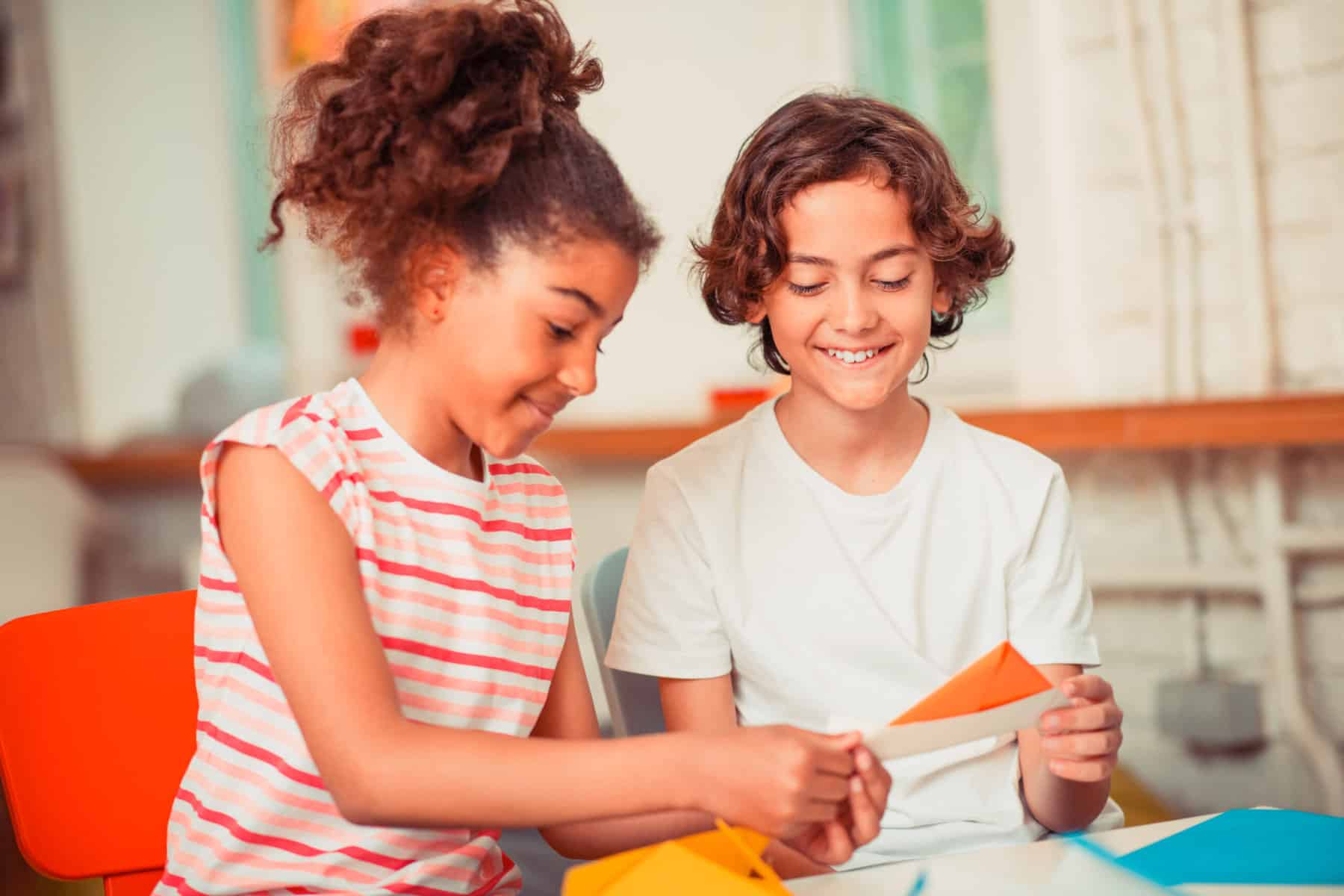
85 Creative Activities For Teaching Kids About Feelings
In order to get kids to buy into feelings identification activities, it’s important that you:
- Choose activities that are appealing, age-appropriate, and relevant to kids’ interests. Tailor the activities to kids’ preferences and incorporate elements of play. Also, use creative approaches such as games, art, or storytelling.
- Build a trusting and supportive relationship with your students. When you have a positive rapport with kids, it increases their willingness to participate in activities. They don’t mind experimenting with new activities in session, even if it makes them feel uncomfortable. They do it because they trust you.
- Explain the purpose and benefits of the activities in a child-friendly manner. When kids understand the value of using activities in the therapeutic process.
But first, here are nine strategies to help teach kids about feelings and emotions.
1. Teach kids to mindfully notice their feelings. Encourage them to sit and notice what their emotions feel like in their bodies. For instance, if they’re anxious, it might feel like butterflies in their bellies, racing heartbeat, etc.
2. Help kids notice what thoughts come up with their emotions. The thoughts you have significantly influence the emotions you feel. For instance, when you think worry thoughts like, “What if no one wants to be my friend? Or “I’m going to sound stupid when I talk,” you’re likely to feel anxious and inadequate.
You can help kids understand the relationship between their thoughts and feelings by getting them into the habit of noticing the thoughts that come up with their emotions. For example, you can say, “I notice your hands are shaking, and you’re sweating a lot. You look scared. What thoughts do you notice in your head right now?”
3. Build kids’ feelings vocabulary. Help kids learn to label their feelings by teaching them feelings words beyond happy, sad, and angry. It’s a lot easier to get your needs met and talk about your feelings when you have the language to do so.
4. Talk about feelings. Show kids how to use feeling words by talking about your feelings. For instance, “I feel nervous because I have to talk in front of the whole school during the assembly later.” You can also talk about how you think other people are feeling. ” He’s yelling, and his face is turning red. He looks like he feels angry.”
5. Name feelings for kids as they’re experiencing them. For instance, “You’re clenching your fists, and your face looks tense. You look angry. Are you feeling angry, or are you feeling something else?”
6. Make daily emotions check-ins part of your routine. Be intentional about asking kids about how they’re feeling. This gives them an opportunity to pause and notice any feelings that are coming up for them. Once they identify their feelings, they can start exploring ways to manage their emotions.
7. Validate children’s feelings. It’s important to let kids know that their feelings are OK. There are no right or wrong feelings. Share with kids that you understand and respect their feelings. For instance, “I see that you’re upset about what’s going on. This must be so hard for you.”
8. Practice compassion. Remind children that everyone experiences emotions and that their feelings are completely natural and normal. You can try saying, “It’s OK to feel angry. A lot of people would feel angry if that happened to them.”
9. Give positive reinforcement. Praise kids when they express their emotions in prosocial ways. This might sound like, “I’m really proud of you for staying calm and using your words to express yourself.”
Art Activities For Identifying Feelings
- Draw Your Feelings. Have kids think about the last time they experienced an emotion (sad, angry, mad, etc). Then have them picture the feeling in their head and draw what their feeling looks like.
- Emotion Robot– This cute Emotion Robot from Lemon Lime Adventures is easy to make and kids will have approximately fifteen minutes to craft, color, and play with their robot as they learn about emotions.
- Lego Feeling Faces-Help kids learn about their emotions with this LEGO Feelings Faces template from And Next . They get to design feeling faces for LEGO mini-figures and use them as conversation starters to talk about feelings.
- Feelings Collage. Children can cut pictures out of magazines (or print pictures off the internet) showing people expressing different emotions. Next, they can sort the pictures and glue them into groups based on emotion.
- My Many Colored Feelings-In this My Many Colored Feelings activity by Mosswood Connections, children explore their feelings using colors. “Children can easily relate to attaching colors to their feelings and this opens up a whole new way for children to talk about and explore their emotions.”-Mosswood Connections
- Caesar the Emotional Dragon– In this simple emotions art activity, kids use their creativity and emotional vocabulary to bring Caesar, the Emotional Dragon to life!
- Happy/Safe Place Drawing-This mindfulness activity teaches kids how to visualize and connect with feelings of happiness. You can read the Happy Safe Place script or follow the instructions below.
- Think about a place that makes you feel happy. It can be imaginary or real.
- Spend a few moments thinking about this place,
- First, what do you see?
- What do you hear?
- What can you touch?
- What can you smell?
- What can you taste?
- Notice all the little details and draw what you visualized. You can come back to your happy place whenever you need to.
- Feelings Spinner-Make a colorful Feelings Spinner with paper plates to explore the different emotions. This is a great activity to complete after watching the movie Inside Out. You can find all the directions to make the feelings spinners on Meaningful Mama.
- Feelings Scratch Art Mask. Making these Feelings Scratch Art Masks are a great way for kids to turn inwards and notice how they experience different emotions. You can find directions for this activity over at In The Bag Kid’s Crafts.
- Anime Feelings Coloring Sheets. Engage kids to learn about feelings with these Anime Feelings Coloring Sheets. Many kids are into Anime and relate to the anime-style figures. These worksheets will be a favorite for many kids!
Writing Activities That Grow Kids Emotional Vocabulary
- Journaling. Sometimes it’s hard to find the words to say how you feel and writing them down comes easier. Kids can express their feelings by journaling about their experiences at home and at school. They can also write about how they feel about a variety of topics (friendship, losing a loved one, starting something new, etc). I created a Guided Feelings Identification Journal for kids to help them connect with their emotion. Both counselors and kids find this journal useful!
- Write an Acrostic Poem. Acrostic poems are a fun way to get kids to learn about their feelings. Start with a feeling word (happy, lonely, etc) and use it as a theme for the poem. Have kids write the word vertically, and then go down the letters and write a short word or phrase that starts with each letter. Once they complete their poem they can explain what they wrote in details.
- My Feelings Comic Strip-Give kids a set number of panels and challenge them to come up with a quick story about how they’re feeling or about a time they felt a specific emotion. Then, they can illustrate their scene in the style of comic books.
- Dear Feelings-Ask kids to think about the last time they felt upset. Next, have them write a letter to their feelings explaining what it was like for them when they felt those feelings. As a bonus, you can have kids write a response from their feelings.
- Write It Out. In this activity, kids think about their happiest memory and write a poem or short story describing what happened and how it made them feel. You can also have them write about their saddest memory, a time they felt super nervous, etc.
- Picture This: Hang pictures up of people experiencing different emotions. Ask kids to write about what they think is going on in the picture and how they think the people in the pictures feel.
- Feelings A to Z. This activity helps to build children’s feelings vocabulary. Have kids look up and write down a feeling word for each letter in the alphabet.
- Feelings Writing Prompts-Feelings writing prompts encourage kids to turn inwards and reflect on their feelings. Provide children with feeling prompts and have them complete them. Once they’re done, kids can share their answers if they’re comfortable doing so.
Music Activities That Teach Feelings Identification
- Guess That Feeling. In this activity, children listen to certain songs and identify what feelings they notice coming up for them when they hear the music. As an added bonus, kids can draw a picture and color what the emotion they’re experiencing looks like. Here are a few songs you can use for this exercise:
- Curious-Curious Cinematic
- Confused-Instrumental Music
- Angry-Japanese Drumming Kodo O-Diako
- Forgiveness-Carlos Nakai Earth Spirit
- Joy-Happy Curious Kid’s music
- Sad-Sad Emotional Piano
After kids go through the list of songs, ask them to complete the sentence stem, “Right now I feel…” (No music)
*It’s OK if kids identify an emotion that’s different than what’s stated before each song. For instance, if kids listen to Earth music and state they feel sad instead of feelings of forgiveness, that’s fine.*
2. Musical Feelings Bag-Have children sit in a circle. Fill a bag with pictures of items that evoke different emotions (picture of puppies, ice cream, etc). While music is playing, have children pass the bag from one person to the next. When the music stops, the child holding the bag picks out a picture and says what is on it. Ask them to talk about how the picture makes them feel and why. Continue playing until each child has had a turn. You can find more details on how to set up musical feelings bag on the site Play and Learn.
3. Looking at Lyrics-Read song lyrics about different topics (friendships, family, etc.) to kids. Next, discuss the song lyrics (what do they think the lyrics mean? Why? Can they relate? etc.). You can follow the group discussion by singing the song together. Here are a few ideas for song choices:
- Get Back Up Again (Trolls movie)-Anna Kendrick
- Friend Like You-Andy Grammer
- Let it Go (Frozen movie) Indiana Menzel
- How Far I’ll Go (Moana) Auli’i Cravalho
- We Don’t Talk Abiut Bruno (Encanto) Stephanie Beatriz
4. Feeling the Blues. In the PBS show, Pinkilicious and Peterific, Pinkalicious and Peter explore feelings of sadness by using Blues music to help Peter express feelings of sadness. Play the video clip for kids and discuss. You can find the Pinkilicious and Peter video clip and more information on how to use music to support children’s emotional well-being on PBS Kids.
5. Group Sing. In a whole class or small group, have kids write as many emotions or feelings as they can. Next, go through each emotion and discuss how music that represents that feeling might sound.
Feelings Identification Games
- Feelings Jenga. In order to play this hands-on game, you simply need a Jenga set and a marker. On random blocks, write different emotions that you want kids to learn (happy, sad, worried, angry, bored, jealous, etc.). Next, have kids pull an emotion Jenga block out. Then, they share what the emotion means and what makes them feel it. For example, if they pulled the anger block, they would have to describe what anger means and express what makes them angry.
- Feelings Charades. Playing feelings charades gives kids an opportunity to explore how they express their emotions through facial expressions and body language. Kids each pick a feelings card and take turns acting out the emotion on the card as the rest of the class tries to guess what emotion is being acted out. We use our Emoji Feeling Cards in our charades games.
- Emotion Mania Thumball-Many kids bottle their feelings up because they’re either embarrassed, afraid, or simply don’t have the words to talk about what they’re feeling. You can normalize talking about feelings with this Emotion Mania Thumball. Kids get to discuss feelings freely while engaging in a fun game with peers.
- Talking, Feelings, Doing game-The Talking, Feeling, and Doing board game gives kids a chance to talk about feelings they might find hard to bring up in conversation.
- Feelings Board Game-This printable feelings board game created by Life Over C’s helps build children’s self-awareness and is a great activity for helping kids learn how to identify and label their emotions.
- Emotionality: The Game of Feelings-Discover how emotional expressions have changed over time in a game designed to test and stretch kids’ emotional vocabulary as well as take a look at the history of emotional expressions.
- My Feelings Game –This social-emotional game comes complete with 280 different emotional scenarios to work through, as well as movement cards that keep kids interested. This game provides kids with tools to identify their feelings, regulate their emotions, and deal with conflict.
- Silly Street-Here’s a fun and silly game that will help kids learn essential social emotional skills. During the game, kids learn about different emotions they may experience in social scenarios.
- Mixed Emotions–You can help kids learn how to notice other people’s emotions with this game, Golden Path Games Mixed Emotions: An Activity for Cognitive-Behavioral Therapy. It comes with scenario cards of different people confronting situations that might bring up “mixed emotions.” The scenarios include situations involving children, teens, and adults. This mixture allows kids to put themselves in other people’s shoes.
- Feelings Match-The feelings matching game is played like the classic memory game. You’ll need to print out two sets of feeling faces cards so that you have pairs of all the feeling faces.
- Shuffle the feeling cards and then lay them face down.
- Kids will take turns flipping over two cards per turn until they find a match.
- In order to keep the match, players must share what makes them feel the emotion written on the card.
- Players get to go again when they find a match.
- The player with the most matches win.
- This is recommended for one or more players.
- Feelings Ball Toss–Feelings Ball Toss is a fun activity to play with kids to help them understand different emotions. After listening to different scenario cards, kids will toss a ball into a bowl labeled with the emotion they believe best matches how the person in the scenario cards might feel.
- Catch A Feeling–Grab a beach ball and a permanent marker, draw feeling faces in each section of the beach ball. Next, toss the ball. When someone catches it, have them identify the feeling face under one hand and share about a time they felt this emotion.
- Simon Says Feelings Game-Say an emotion and have kids pretend they are feeling that emotion. For example, if you say excited, kids can smile and jump up and down. If you say tired, they could yawn or pretend to sleep.
- Fishing For Feelings– Print out two sets of feelings cards. Like the classic Go Fish game, kids get 5 cards and fish for pairs by asking other players if they have the match they need to make a pair. If the other player doesn’t have the card asked for, they say “Go Fish.” If the player gets a match, they lay the pair down and take another turn. The first player to get rid of all the cards in their hand wins. This is perfect for two or more players
- Feelings Taboo-Give kids a deck of emotion word flashcards.
- Have one player pick an emotion flashcard and describe the emotion to the group.
- Group members take turn guessing the feeling.
- Descriptions might sound like; “It’s how you feel when you get a gift you really want on your birthday” for “excited” or “It’s how I feel before I have to take a big test” for “nervous”
- Remind kids that they can’t say the word on the emotion flashcard or other parts of speech of the same word (e.g. “anger” for “angry”).
- The player that guesses the emotion correctly gets a point. Keep going until each person gets a chance to pick and describe an emotion flashcard.
- Breaking Barriers Down – Social Skills Games and Therapy Games. A feelings game for kids that develops emotion regulation and explores Anger, Sadness, Fear, and Joy.
- Feelings Slap Game-Lay feeling faces cards face up. As you call out a feeling, the player must slap the card that has the feeling face you called. You can use a fly swatter for this game, but kids will have just as much fun using their hands or a pointer. Kids can play this alone or with one other player. When playing with two players, the player who slaps the feeling card first gets to keep it.
Feelings Identification Craftivities
- Emotions Discovery Bottles-This emotions discovery bottle by Laly Mom is a fun DIY craft inspired by the movie Inside Out that helps kids name their feelings.
- Feelings Book-Kids will enjoy turning blank board books into personalized feelings books. Check out a sample DIY Feelings Book over at No Time For Flash Cards.
- Feelings Flipbook. Create this feelings flipbook with your kiddos while talking to them about the different emotions, what they feel like and when they might feel them. The Crafty Family provides detailed directions on how to make a feelings flipbook.
- Feelings Thermometer– The feelings thermometer is a visual tool that helps kids measure how they’re feeling. Once they know they can identify their feelings, they can take steps to cope. You might find this printable Feelings Thermometer helpful.
- Mirror Feelings-Give children a hand-held mirror or have them stand in front of a large mirror. Ask them to use their reflections to explore the facial expressions they make for different emotions.
- Feelings Fortune Teller-Help kids practice and identify feelings with paper fortunetellers. Put kids in pairs and have them use the feelings fortune teller to ask and respond to question about feelings ( NOTE: The activity describes feelings as positive or negative. However, we believe there are no good or bad feelings. Feelings are just feelings, neither good or bad. I recommend you change the language when you present this activity to kids).
- Stop the Drama Thumball- With this interactive game, kids will have a blast discussing different social-emotional scenarios. Have kids take turns tossing the ball to one another. The person who catches the ball looks to the question that their thumb lands on. Then they must answer that question.
- Feelings Scavenger Hunt- In this interactive feelings activity, kids get to search for things that make them feel different emotions. They also get to reflect on times they experienced specific emotions.
- How Would You Feel? (Situation Cards MAKE)
- Emotion Sort-Help kids understand and classify their emotions with this Emotion sort activity:
- Write six basic emotions down on sticky notes or note cards.
- Write down all or some of the emotions for each category. Cut those words apart.
- With your kids, talk about each emotion and where it might fit in one of the 5 basic emotions categories. Put those emotions under the appropriate category.
- Express Your Feelings Sensory Bottles, Play Therapy Toys, Visual Sensory Toys, Mindfulness for Kids, Comfort Items for Anxiety, Social Emotional Learning, Calm Down Corner Supplies https://a.co/d/bNS4Ma5
- Little Folk Visuals Emotions Felt Learning Toy Set, Precut Felt Board Figures for Kids and Toddlers to Learn Feelings and Facial Expressions, 24 Piece Set
- Social Emotional Games for Kids & Toddlers – Make Faces to Describe Feelings & Emotions – 9 Emotion Cards – Social Emotional Learning Activities Toy for Home Classroom – Gift for 3 4 Year Old Girl Boy
- Social Emotional Learning Funny Faces Games with 28 Facial Expressions and 12 Emotional Flashcards, Preschool Learning Activities Toy to Express Emotions for Kids Age 3+
- Soft Foam Emoji Cubes, Set of 4, Ages 3+, Conversation Cubes for Kids, Social Emotional Learning, Back to School Gifts, Teacher Supplies https://a.co/d/7Hguj2q
Movement Activities To Explore Feelings
- Musical Feelings– This activity is a spin on the classic game of musical chairs. Place cards labeled with different emotions on the ground. Kids can dance, hop, walk, or jump from each card while music plays. When the music stops, kids must act out the feeling they landed on.
- Dance Party. Make a list of emotions and have kids pick clean versions of songs they believe evoke those feelings. Make a playlist of the songs and have a dance party!
- Feelings Parade. Ask kids how they would march to different emotions. For instance, “How would you march if you were angry?” “What if you were feeling excited, proud, or playful?” “How would you march if you were feeling tired? Or disappointed?” Encourage kids to be expressive with their bodies and facial expressions.
- Mood Walk-Take kids on a mood walk and get them to explore, name, and act out their emotions! In this activity, you’ll give kids directions on how to walk like different emotions. For instance, tell kids, “walk like you’re impatient. Take jittery steps. Walk side to side. Make a scrunched up face and clench your jaw. Ring your hands. Look at the clock or watch.”
- Feelings Yoga-Yoga is a great way to move your body. It’s also a great way to express your feelings. In this video, Play Guide Mandy and Teacher Lauren combine feelings and yoga into a fun activity that gets kids to explore their feelings through Yoga poses such as the Grateful Giraffe (extended mountain pose) and Finnicky Flamingo (tree pose).
- Kids Yoga Read A Loud-My Many Colored Days-Teach kids about feelings with a Yoga lesson based on the Dr. Seuss book, My Many Colored Days. My Many Colored Days talks about how kids may have different feelings and emotions on different days, and how those feelings might affect them.
- Feelings Freeze Dance-Freeze dance is a great way to get kids moving. Turn on some kid friendly music and play a snippet of a song. Next, pause the song. When the song is paused, tell kids to freeze and show a feeling face (show your happy face, sad face, etc).
Dramatic/Pretend Play Activities To Explore Emotions
- Act-out Your Feelings-Give kids a poem or passage to read. Next, kids pick an emotion word from a jar. Have them read the selected material with the emotion they chose. For instance, if they pick angry, they have to read the passage using body language, facial expressions, and tone of voice to show anger.
- Feelings Pretend Play: Have children act out different real-life situations such as one puppet takes a block from another puppet. Ask kids to act out how they think the puppets would feel.
- Paper Bag Puppets-This fun craftivity shows kids how to make puppets out of paper bags that they can use to act out and discuss feelings. Find out how to make paper bag puppets on Kids Activities.
- Paper Plate Emotion Masks-Open a dialogue with kids about feelings with these paper plate emotion masks found over at No Time For Flash Cards.
- Popsicle Emotions Puppet-Introduce different emotions and their names using these popsicle emotion puppets. Give each puppet a different expression and explore what emotion this expression shows. “What is the feeling called? What face do you make when you have this feeling? What makes your feel this way?”
- Toilet Paper Roll Emotion Buddies-This easy feelings craftivity teaches kids about their feelings and gives them a chance to act out different feelings as they play.
- Emoji Feelings Puppets–https://www.kiddiematters.com/emoji-feeling-faces-feelings-recognition/
- Ready Made Hand Puppets-If you’re short on time or want to jump into teaching kids about feelings, the following ready-made hand puppets are fun, effective ways to engage kids in a conversation about feelings.
- Feelings Family Hand Puppets–Hand Puppets for Kids, Social Skills Activities, Mindfulness for Kids, Social Emotional Learning Activities, Sensory Play Therapy Toys for Counselors (Set of 5)
- Multicultural Hand Puppets with Movable Mouth (8 Pack) Bulk Soft Plush Puppets, School Home Puppet Theater Shows Toys, Teachers Classroom Supplies
Videos About Emotion Identification
- Guess the Feeling-In this video, kids learn about feelings and emotions by playing a guessing game. During the video, an image of an emotion is shown and kids have 5 seconds to guess what the emotion is. The emotions shown are happy, sad, angry, excited, confused, shocked, scared, proud, bored, surprised, strong, tired, exhausted, hungry, and thirsty. (They also include respect and celebrate. However, I didn’t present these as feelings but instead asked kids how someone might feel when others show them respect and are kind to them ).
- PBS Kids Talk about feelings-In this video, parents and other adults talk to children about feelings. Kids are asked:
- What do feelings mean to you?
- Why is it important to share your feelings?
- When was a time you had to talk about big feelings?
- When is it hard to share your feelings?
- When you can’t talk about your feelings, what can you do instead?
- How did you calm down when you experienced big feelings?
- The video also shows how adults can help children learn about feelings by using feeling words when they tell children stories. At the end of the video, the kids and adults play feeling charades. You can use this video to start a discussion with kids about feelings. Have them share their answers to the feelings prompts in the video.
- Emotion For Kids-This video helps kids learn about their emotions by using an emotions wheel. After the wheel spins and an emotion is selected, a description of the feeling is given and an example of a situation that would evoke the emotion is shared. You can pause the video before moving on to the next emotion to ask kids about a time they felt the emotion being discussed.
- Feelings and Emotions Vocabulary-This video uses animations to teach children a variety of feelings such as happy, sad, upset, excited, afraid, brave, amused, angry, furious, ashamed, bored, cold, hot, confused, tired, surprised, nervous, proud, puzzled, relaxed, sick, sleepy, thoughtful, worried, shy, kind, malicious, jealous, overwhelmed, shocked, guilty, scared, content, in love, astonished, and embarrassed. You can share the video with kids and pause video during certain emotions to explore more deeply. (Note: I didn’t present malicious and kind to my kiddos as feelings, but instead asked kids to come up with how someone who is being malicious and kind might feel).
- Know Your Emotions-This is a great resource for explaining what emotions are and how to express them. In this video, kids learn about the intensity of their emotions, that emotions come and go, and that there are no ‘good’ or ‘bad’ feelings. After watching this video with kids, ask them to draw an emotion intensity meter (as seen in the video) to show how they’re feeling right now.
- Alfred & Shadow-A short story of emotions (for older kids)-This is a helpful video for guiding a discussion with kids and teens about feelings. They’ll learn about how feelings develop, how past experiences influence their emotional reaction to current stressors, and healthy and unhealthy ways people express and cope with their feelings. Have a discussion with kids about the different ways they express and cope with big emotions.
- Anger for kids. What is anger? You can share this video with kids to give them a general overview about feelings. Following the overview, anger is discussed in detail. Kids learn about different situations that can trigger anger and ways to calm down. They also learn different ways people express anger. (At the very end of the video, feelings are described as being negative and positive. This isn’t in alignment with what I teach kids and I repeatedly remind them that feelings aren’t good or bad. They just are.)
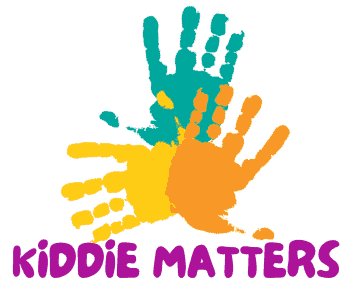
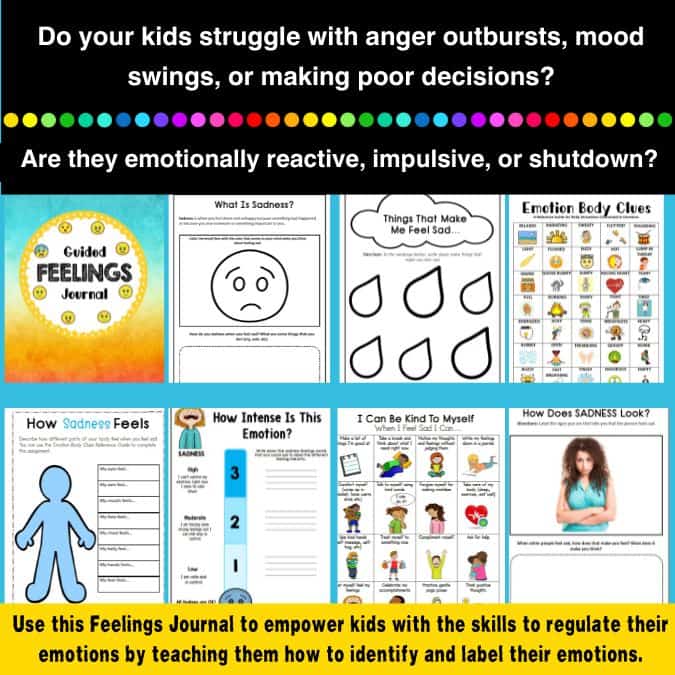

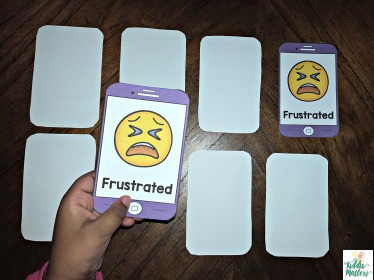
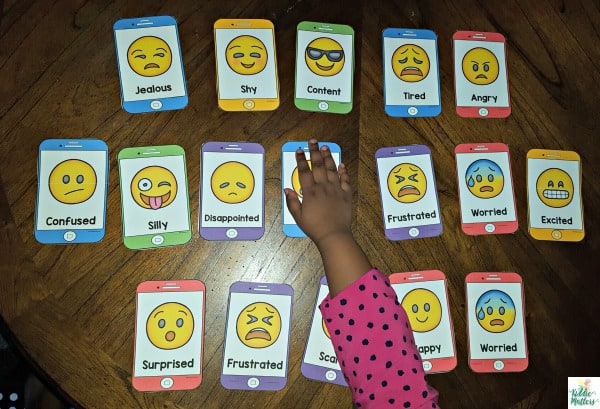







Thank you for these great tips and activities ideas ! This week, I’m doing feelings with my kindergarten students, I’m sure the feeling dice will be a sucess 🙂 Thank you for sharing.